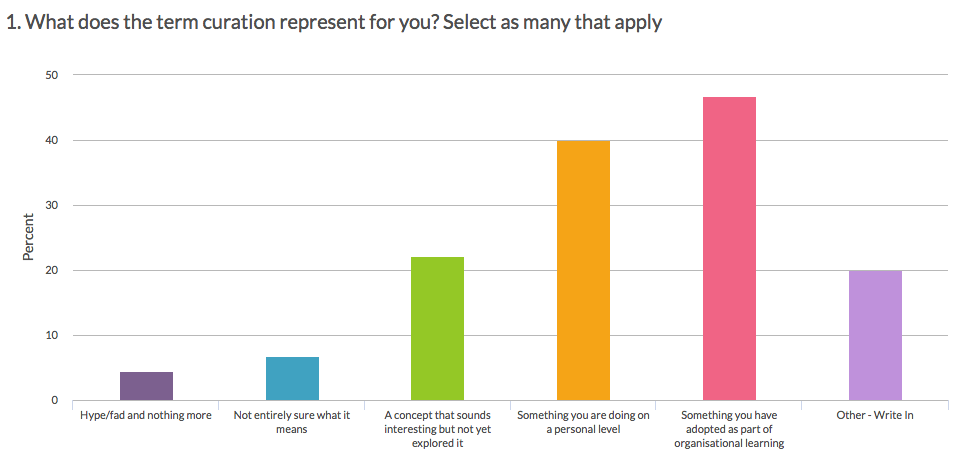If you were going to introduce curation into learning in your organisation, what would you do? What would it look like and how would you do it?
The reason I ask is because curation is an odd word for learning and development. It is odd in the sense that it is not known for having anything to do with corporate training. Curation is known in the art world and the museum world. In those two worlds, it is a discipline in its own right – you can train and take qualifications in curatorship.
In recent years, however, the term curation has become increasingly important and prevalent in L&D. The reason for that is the explosion of content online, content that enables employees to freely and independently access work related resources. They can do this without seeking the sanction of their employer.
With the growth of information online comes the challenge of distilling what’s actually worth looking at, listening to or watching. That has become a personal and professional challenge and also an organisational challenge. Why pay to create more content when you could pull together the best of the web?
This is the essence of curating in learning. In a recent post on L&D Jargon, Nick-Shackleton-Jones, director of learning and performance innovation at PA Consulting, provided a similar definition:
Curation: gathering together existing content rather than creating it, and recommending some items rather than others.
As a simple definition, this is a start. If you were going to start curating as a part of your learning offering then gathering together existing content rather producing new content is a good place to start.
But there is actually more to curation than just this, which is why we need to expand on what it means. There is also some confusion about its meaning within the L&D profession. Take my own, albeit small, research of 45 L&D professionals. A few of the participants thought it was a fad or were unsure what it meant. One respondent said: “Curation happens, but it’s not referred to as curation, it’s just another training method.”
So, what is curation in learning?
There are three ways to think about curation in learning. They are:
1. As an approach to learning design
2. As an approach to personal knowledge management
3. As an approach to organisational knowledge management
As an approach to learning design
The word curation comes from the Latin cura, to care. This is a useful starting point. Curators take care over the work they curate, how they present it and who they curate it for. Think about museum curators and the experiences they create for their audiences, for example.
Think about curation in the context of learning: curators take care throughout the learning design process, from understanding the performance issue and the audience to delivering resources in the most relevant, useful and timely manner. So before you start gathering resources, think about creating your ‘brief’ – the document that spells out what is needed, why and for whom. Be clear on what success looks like too.
At the heart of curation is an open and inquisitive mindset. Being clear on what needs to be achieved requires much questioning and a desire to really understand what needs fixing. Why is this important? Because if you aren’t clear on this, you’ll curate resources that are of little use to anyone. Curators start by understanding the performance problem. Remember, training may not be the solution.
More questioning and understanding of the problem and user requirements will help shape your thinking on what the final design should look like. I have produced a short guide to help with this, which you can access here.
The final execution of the design will include resources that you pull together in such a way that make sense to the user. This will include commentary, much like the explanations of paintings (or audio guides) you see in art exhibitions. It will also include devices to make it as easy as possible to access and use resources – for example, a reading time next to content and icons to show different media formats.
As an approach to personal knowledge management
Curation is also a useful approach to personal knowledge management. This is something Harold Jarche, a thought leader in L&D, has explored in depth over many years. At its heart is a simple process Jarche calls Seek, Sense and Share (I use a similar approach – Find, Filter, Share).
With so much content available to us, the process helps us seek out high quality information, make sense of it and share it with others – your network, peers, colleagues, customers and so on.
As with the approach to learning design, personal knowledge management requires an open mind and a desire to seek out high quality information. Seeking out information will require you to establish the provenance of what you consume before you share it. That means you might have to triangulate against other sources. This is important because it is so easy to share content that is low quality or possibly fake. Trusted sources of information are essential.
You will also need a purpose for curating content because it takes time and will require you to make time (and create new habits) to do it – more on that in a future article. Why are you curating information on a particular topic? Who is it worth sharing with? How would they like to receive the information? Why is it important to them? Your role as a curator will help you build up your own knowledge and that of others. Your content can also act as a catalyst for building connections with others and starting conversations related to that topic. Be prepared for that to happen – curating information can be a two-way street.
Personal knowledge management requires using tools to bring the web to you, rather than spending hours clicking around websites. I’ll discuss some tools in a future article but tools like Nuzzle, which brings you links shared by the people you follow on Twitter, are good for helping distill the web.
As an approach to organisational knowledge management
Can personal curation scale to benefit the entire organisation? Yes, but only if you stick to the principles above. Always have the end user and their needs in mind and deliver what they need in the right way and at the right time. Use data and feedback to continually tweak what you curate and establish a process to revisit resources to ensure they stay up to date.
The opportunity here is to develop curation skills within your organisation with a particular focus on subject experts. Every organisation is different, but a common approach to test out the process would be to start with a team. Start with your own team. Curate and share insights to help build knowledge and skills in your team. See how it works, what needs tweaking and keep adjusting until you have a process that works and provides value for the entire team.
Then use this insight to invite other teams to try the same approach. Be agnostic on the tools to be used. Focus on sharing resources in places where people can easily access them. And bear in mind that over time, you will create a repository of useful resources. Think about where that needs to be, how to brand it and how to make it very easy to access and use.
We developed a curation platform for one of our clients. It is is a simple Wordpress site that acts as the repository of links (organised by keywords) and we email out latest links each week. It’s a simple and effective platform using a common, well used communication channel – email.
Conclusion
I would like to return to those questions I posed at the start of the article: if you were to introduce curation into learning in your organisation, what would you do? What would it look like and how would you do it?
I hope these definitions provide some ideas to get started. This is the first in a series of articles. The rest of the series will cover:
- Curation for learning: 3 key characteristics
- Curation for learning: a new design approach
- Curation for learning: Barriers
- Curation for learning: Where’s the value?
- Curation for learning: can it scale?
- Curation for learning: useful hacks/tools to get started






